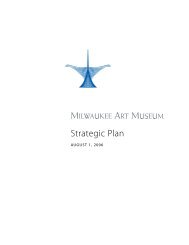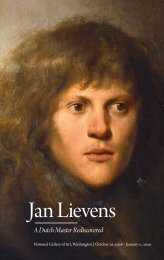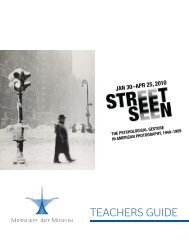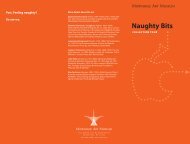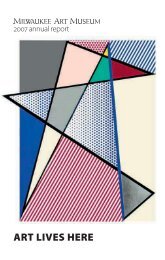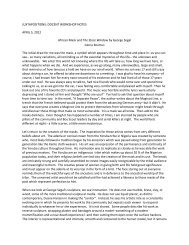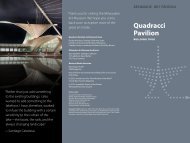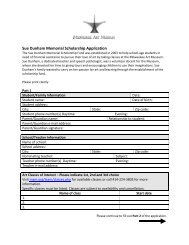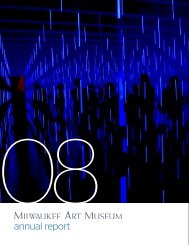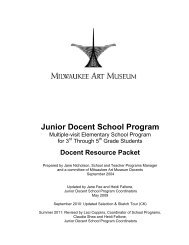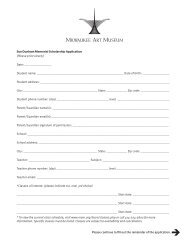2012-2013 JDSP Teacher Resource Packet - Milwaukee Art Museum
2012-2013 JDSP Teacher Resource Packet - Milwaukee Art Museum
2012-2013 JDSP Teacher Resource Packet - Milwaukee Art Museum
You also want an ePaper? Increase the reach of your titles
YUMPU automatically turns print PDFs into web optimized ePapers that Google loves.
and then spread throughout northern Europe. Greek and Roman art, science, and literature<br />
all were rediscovered, and these grew tremendously during the Renaissance.<br />
The major breakthroughs were the change from tempera paint on wood panels and fresco<br />
on plaster walls to oil paint on stretched canvas; the use of perspective, giving weight and<br />
depth to form; the use of light and shadow, as opposed to simply drawing lines; and<br />
pyramidal composition in paintings.<br />
European Baroque artists filled their paintings with action, drama, and emotion. Whether<br />
the image was a religious subject, mythological theme, battle, hunt, or portrait, Baroque<br />
artists gave drama to the ordinary scenes they depicted in their artwork.<br />
Realism and Naturalism (1830s–1870 CE)<br />
In the 1800s, the Industrial Revolution caused many social and economic problems. There<br />
was growing concern among artists and writers about the plight of ordinary persons at<br />
home and at work. The concern was reflected in the style of art that became popular in the<br />
mid-nineteenth century. Realism/Naturalism implied a desire to depict things accurately and<br />
objectively. <strong>Art</strong>ists limited themselves to the facts of the modern world as they personally<br />
experienced them; only what they could see or touch was considered real. They painted<br />
real life: everyday problems, work, etc. They were interested in the matter of subject rather<br />
than style.<br />
These artists handled their brushes and painted in ways that brought more textures and<br />
visual interest to their paintings. The invention of the camera gave them the possibility of<br />
working from a photograph, an entirely new concept during this time. The Realists’ desire to<br />
paint in the open air and interest in how light affected one’s perception of a scene paved<br />
the way for Impressionism.<br />
Impressionism (1860s–1880s CE)<br />
The European Impressionists began in the tradition of Realism. They favored subjects that<br />
appeared informal and spontaneous. However, it was the manner in which they painted,<br />
and not the subject matter, that defines Impressionism.<br />
The Impressionists adapted some of the science of optics researched in the nineteenth<br />
century. They understood that when we look at something, we see not the object itself, but<br />
light reflected from the object. To capture this optical sensation, Impressionists worked<br />
outdoors on small canvases and painted with small brushstrokes. In doing so, they were<br />
able to produce a feeling of spontaneity rather than of posed studio effects. They created<br />
bright paintings with brilliant colors that almost shimmer in their intensity, and which paved<br />
the way for abstract art.<br />
Abstraction (late 1900s–1940s CE)<br />
Abstraction applies to art that looks as if it contains no recognizable forms from the physical<br />
world. All the artist gives us to focus on are colors, lines, shapes, values, forms, textures,<br />
spaces, and materials. Abstractionists carefully painted and arranged colors and cleanly<br />
outlined geometric shapes. These artists explored new ways to combine the elements of art<br />
(line, shape, color, form, texture, value, and space) in non-objective paintings and<br />
sculptures to express feelings; they distorted shapes and rearranged parts, reconstructing<br />
© <strong>2012</strong> <strong>Milwaukee</strong> <strong>Art</strong> <strong>Museum</strong> 700 N. <strong>Art</strong> <strong>Museum</strong> Dr. <strong>Milwaukee</strong>, WI 53202<br />
<strong>JDSP</strong> – <strong>Teacher</strong> <strong>Packet</strong><br />
31



